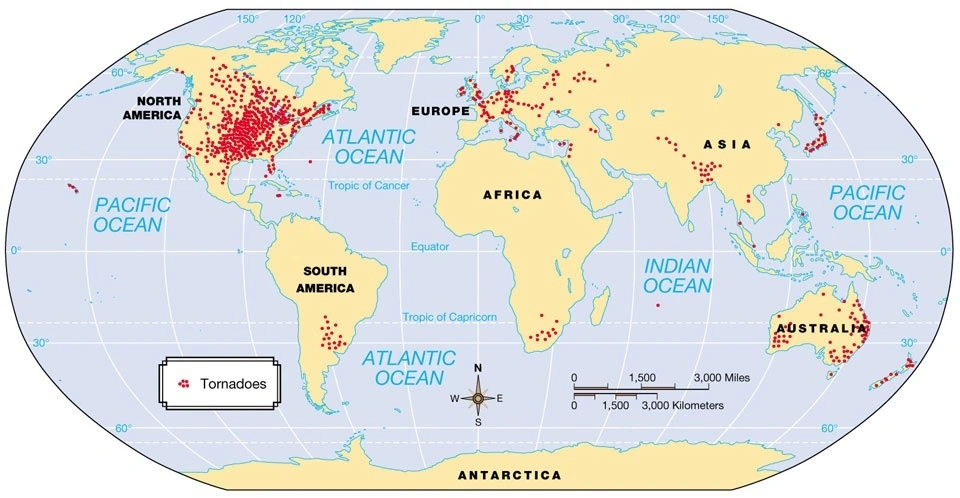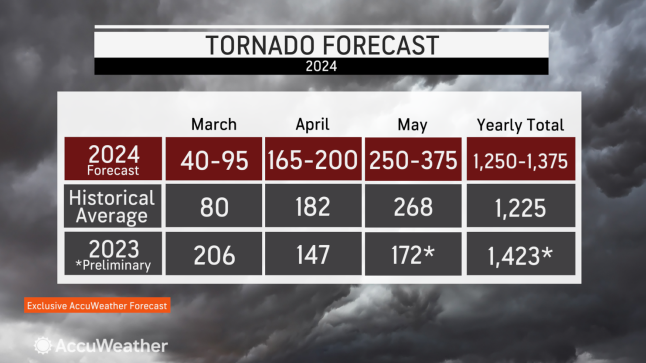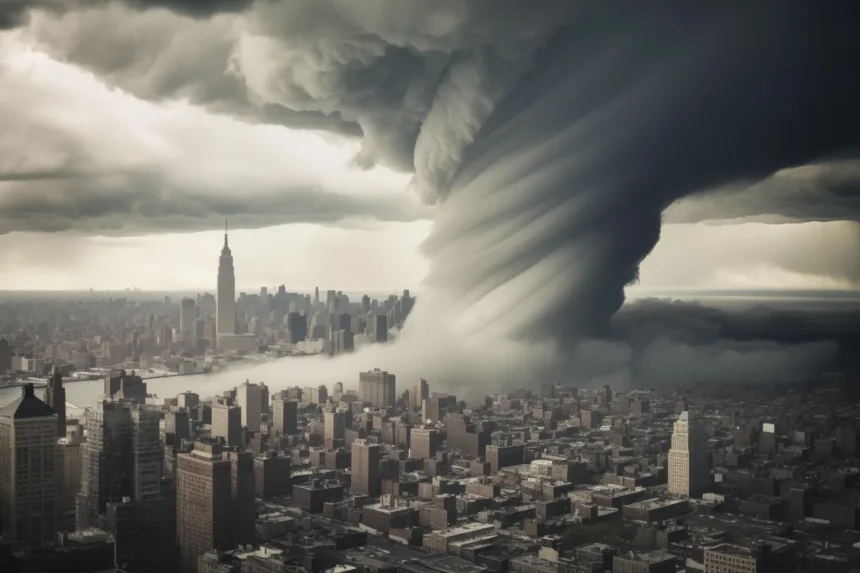⫸ Introduction to Tornadoes in the United States
The United States endures many tornadoes yearly, making it a global hotspot for these destructive storms. While tornadoes can touch down on nearly every continent, the U.S. sees more of these whirling columns of destruction than anywhere else. But why?
The reasons for the United States tornado dominance stem from a unique combination of geographic and atmospheric factors. The country’s vast, open plains provide an uninterrupted arena for powerful storms to develop, fueled by the meeting of warm, humid air from the Gulf of Mexico and cooler, dry air from the Rockies. This clash of air masses sets the stage for the extreme instability and rotation needed for tornadoes to form.

⫸ Perfect Storm: Understanding the Unique Geography of the U.S.
The United States faces a level of tornado activity unmatched by any other nation. Why is this the case? The answer lies in a unique convergence of geographical factors that create a perfect breeding ground for these destructive storms.
The Great Plains - A vast, flat incubator for severe weather
The nation’s heart, the Great Plains, stretches from the Rocky Mountains to the Mississippi River. This flat, unhindered terrain allows for massive meteorological battles; no mountain ranges or major bodies of water can disrupt the flow and development of powerful storms fueled by the conditions described below.
Clashing Air Masses – Warm, moist Gulf air meets cool, dry Rocky Mountain air
The Gulf of Mexico provides a near-endless supply of warm, moist air. This humid air mass collides with cooler, drier air descending from the Rocky Mountains. This clash of temperatures and humidity creates instability – a crucial ingredient for severe thunderstorms. As the warm air rises rapidly, the potential for powerful updrafts that can form tornadoes increases dramatically.
The Role of the Jet Stream - High-altitude winds steering and intensifying storms
The jet stream, a powerful river of air flowing high in the atmosphere, acts as a key conductor in the United States’ tornado symphony. This fast-moving wind often swoops down into the heart of the Plains, guiding storm systems and intensifying their dynamics. It can create wind shear, where wind speed and direction change with altitude, providing the crucial rotation that can lead to the birth of tornadoes in the United States.
⫸ Supercells: The Powerhouse Behind Violent Tornadoes
While not all tornadoes are born from supercells, understanding these monstrous storms is key to grasping why Tornadoes in the United States are often so destructive. Supercells are a unique breed of thunderstorms, possessing a powerful rotating element that sets them apart and lays the groundwork for extreme weather events.
What are Supercells? – Unique rotating thunderstorms
Supercells are not your average thunderstorm. They are long-lived, highly organized storms with a persistent rotating updraft called a mesocyclone. This rotation distinguishes them and gives them the potential to produce violent tornadoes, large hail, and damaging winds. Think of them as the powerlifters of the storm world.
Conditions for Supercell Formation – The ingredients needed
For a supercell to form, several atmospheric ingredients must come together:
- Instability: Warm, moist air near the ground needs to rise rapidly.
- Wind Shear: As wind patterns shift in speed and direction across different atmospheric levels, they generate horizontal rotation.
- Trigger: A lifting force like a front or mountain range to kickstart the storm.
How Supercells Spawn Tornadoes—The mechanisms involved
The process within a supercell is complex, but here’s the gist:
- Rotating Updraft: The mesocyclone’s rotation tightens and intensifies as it draws in more air.
- Downdraft Entanglement: A rain-cooled downdraft can wrap around the mesocyclone.
- Tornado Formation: This interaction can further tighten the rotation near the ground, potentially leading to a tornado touching down.
⫸ Beyond Science: Tornado Alley and Tornado Forecasting
The science behind why the US experiences so many tornadoes is fascinating, but the real-world impact comes down to geography and technology. Let’s explore Tornado Alley, the advancements in forecasting that save lives, and why ‘Tornadoes in the United States’ is a phrase that sends shivers down spines.
Tornado Alley – The heartland of tornado activity
Across the United States, tornadoes can erupt with fury, but a specific region experiences a dramatic spike in their frequency. Nicknamed “Tornado Alley,” this corridor stretches from Texas northward through the vast, flat expanse of the Great Plains.
A confluence of dangerous ingredients brews: expansive flatlands offer minimal friction for developing storms, warm, humid air masses from the Gulf of Mexico clash with cool, dry air masses, and the high-altitude jet stream acts as a conductor, steering and intensifying these storms. This unique combination doesn’t necessarily guarantee a higher number of individual tornadoes, but it significantly increases the likelihood of storms within this region reaching a devastating intensity.

Advances in Tornado Forecasting – Doppler radar and storm-chasers
Decades ago, tornadoes often struck with little warning. Today, things are vastly different. Doppler radar revolutionized severe weather detection. This technology can ‘see’ inside storms, revealing rotation indicative of potential tornadoes. Alongside radar, dedicated storm chasers act as the eyes on the ground, providing crucial confirmation and insights to meteorologists.
Warning Systems – Saving lives through modern technology
The final puzzle piece is getting forecasts and warnings out to the public. The network of tornado sirens, TV and radio broadcasts, and smartphone weather alerts is a lifeline. These systems buy precious minutes for people to seek shelter when ‘Tornadoes in the United States become terrifyingly real. While the US still leads in tornadoes, the decline in tornado-related deaths is a testament to the power of science and communication.
⫸ Are We Seeing the Impacts of Climate Change?
The relationship between climate change and tornadoes in the United States is complex and hotly debated. While rising temperatures might seem like an obvious recipe for more frequent and intense storms, the connection between climate change and tornadoes must be clarified. Let’s delve into the current research and concerns:
Climate Change and Tornado Frequency – Conflicting Research and Concerns
While a warmer atmosphere has the potential to fuel more intense thunderstorms, research on the direct link between climate change and tornado frequency remains to be conclusive. Analyzing historical records reveals no obvious increase in tornadoes in recent years. Evidence suggests a potential decrease in the frequency of strong tornadoes (EF2 or above).
However, we still need to be clear. A warmer climate can hold more moisture, a vital ingredient in forming severe storms. This raises the concern that, even if the overall number of tornadoes stays the same, the proportion of extremely destructive and powerful tornadoes could increase.
Potential Shifts in Tornado Patterns – Possible Changes in Tornado Distribution
While overall frequency remains debatable, scientists suggest climate change could influence where and when tornadoes strike. Warmer temperatures might cause Tornado Alley to creep eastward and northward. Additionally, researchers project that tornado outbreaks, or clusters of tornadoes within a short period, could intensify, even if the overall number of tornadoes stays the same.
While the link between climate change and tornadoes in the United States is nuanced, it’s an area of active research. Even without a rise in overall frequency, potential changes in intensity and distribution still pose significant risks for communities across the country.
Conclusion
Tornadoes in the United States prevail due to a complex interplay of natural forces. The country’s unique geography, with its expansive plains and clashing air masses, creates a perfect breeding ground for severe storms and the supercell thunderstorms that often spawn tornadoes.
While we’ve made significant strides in understanding tornadoes in the United States, ongoing research is crucial. As the climate changes, it’s vital to investigate potential shifts in tornado patterns and intensity. Improvements in forecasting and warning systems will continue to save lives, ensuring we stay one step ahead of these devastating natural phenomena.
⫸ FAQs of Tornadoes in the United States:
Q: Why are there so many tornadoes in the United States?
A: The U.S. has a unique combination of geography (the vast Great Plains), clashing air masses, and powerful jet stream patterns that create perfect conditions for severe storms and tornadoes.
Q: What is Tornado Alley?
A: Tornado Alley is a loosely defined region in the central United States with the highest concentration of tornadoes. It includes parts of Texas, Oklahoma, Kansas, Nebraska, and other nearby states.
Q: How are tornadoes formed?
A: Tornadoes form within powerful thunderstorms called supercells. These rotating storms create the conditions for strong updrafts and twisting winds, which can birth a tornado.
Q: Can climate change make tornadoes worse?
A: The relationship between climate change and tornado frequency is complex. While warmer air can fuel stronger storms, research is ongoing to see if this translates to more tornadoes or an increase in the intensity of the most powerful ones.
Q: How do we stay safe from tornadoes?
A: Tornado watches and warnings are your best defense. Heed official warnings, have a safe place prepared (like a basement or interior room), and know your community’s alert system.

